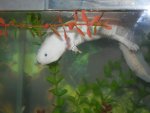Munchausen
New member
- Joined
- May 7, 2009
- Messages
- 67
- Reaction score
- 0
- Points
- 0
- Country
- United States
I have two full grown axolotls. One is a 6.5 year old male, the other is a 3.5 year old female. The female has bite the male's left forelimb VERY badly today or last night. Much of the meat is missing and skeletonized limb is sticking out. It makes me uncomfortable thinking about it. I've never had this happen before and I don't know what to do. I've had juvenile ones completely remove body parts and survive and regrow them. I've never had just skeletonized limbs before, or on a old one. The wounded male has looked a little paler this passed week though.
Right now I moved the suspected aggressive one to another tank of aged partially aged water. Each has an airstone.
What do we do? Sorry the picture sucks!
Right now I moved the suspected aggressive one to another tank of aged partially aged water. Each has an airstone.
What do we do? Sorry the picture sucks!




